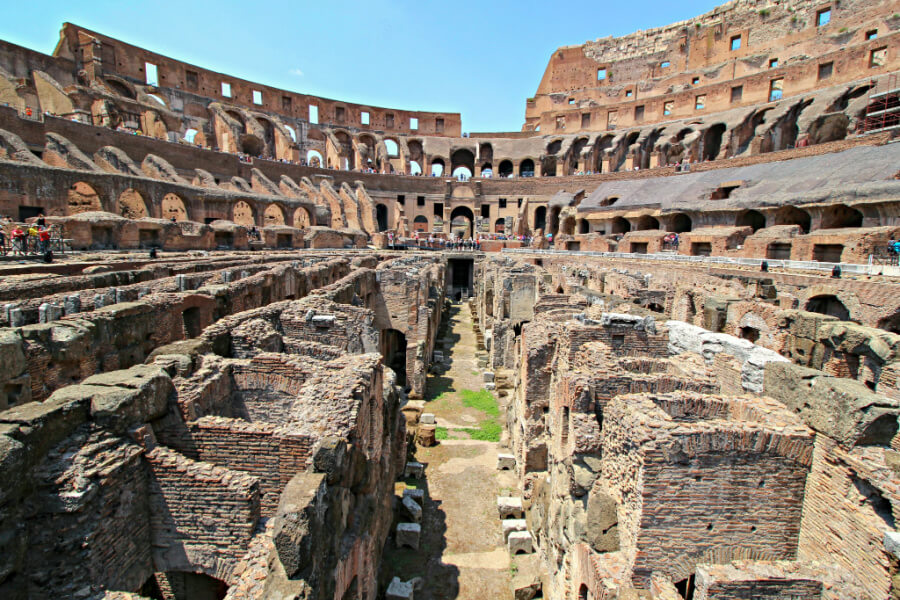One of the 7 Wonders of the World since 2007, the Colosseum is the unequivocal symbol of the Imperialistic Rome.
It was built under Emperor Vespasian between 72 and 83 a.D. as his gift to the people of Rome.
We are talking about a gigantic building at the time
Its original name is “Amphitheater Flavio”, because it was built by the Flavia Dynasty.
Located where Nero’s private residence, the Domus Aurea, used to be. A monumental residence, that spread from the Palatine Hill all the way to the Esquiline Hill. In one of the “small” halls of the Domus Aurea once was the famous Colossus of Nero. An imposing 38 meters-tall Bronze statue, to highlight and amplify the “magnitude” or the ego of its owner, some might say. No one knows exactly for how long the statue was standing, or for how long, some say until the 4th and the 7th Century a.D. And there are so many legends involving its disappearance, because the statue at some point in time, has vanished.
But how can you simply move a statue that big without making a fuss?
Some say that a devastating earthquake broke her down, others say that it was stolen during the famous sack of Rome, but who knows.
Because of its enormous proportions and because it used to stand tall in front of the Amphitheather, even though the Statue is nowhere to be found today, the term Colosseum is officially coined by the people of Rome. A tribute to that tall-standing representation of Imperial Rome: Even though, the original name is Anfiteatro Flavio, it will always be the Colosseum to the Romans.

The Colosseum was built for entertainment, primarily. For all sorts of gory games.
Try to imagine, Emperor Titus, back in the 81st Century a.D., rise from the bastions, to announce the first Games that would last a hundred days, in front of a swarm of men, gathered by the thousands in a festive crowd (the Colosseum could host up to 50 thousand spectators!)
And games that came for centuries to come, of hunting, battle reenactments, fights, adapting to satisfy new requests and styles, changing in time, including Gladiator fights.
But not everybody could enter the amphitheater. To see the games you had to own a sort of membership card, made of different materials including bronze and copper, that had inscribed the number of the entrance arch the member had access to. With the beginning of Christianity, the Gladiator games were not so requested by the spectators anymore, so they were gradually replaced with hunting scenes, and the last Gladiator fight in the history of the Colosseum took place in 523 aD.
At the end of its glorious era, the Colosseum shut down and was abandoned. But it was later repurposed as quarry, from which was extracted the materials used to built some important buildings in the city of Rome. Including Saint Peter’s Basilica, possibly the most important of all.
In Gladiator times, the Colosseum earned an unfathomable and horrific fame: aside from the thousands of deaths, this place also hosted gory rituals and its said that witches and sorcerers used to pick wild herbs there, that grew inside the amphitheater, in the 1500s.
Thousands of years of history, shaped in a caldron of so many creeds, traditions, engineering, cultural facts and customs.
But as we know, its fame becomes Worldwide possibly thanks to the dozen of movies, featuring Ancient Roman times. Including the most recent: Ridley Scott’s, Oscar winning film, the Gladiator. With actor Russell Crowe. Who’s devotion to Rome is palpable through his lead in this movie, filmed 22 years ago, but also through his visits, every so often, in the Eternal city. Only recently this summer, did he jokingly Tweet a picture of him and his family at the feet of the Colosseum, saying “Taking the kids to see my old office“. And earlier this month he was nominated Ambassador of Rome in the World, by the mayor of Rome. Of course, who better than Massimo Decimo Meridio to fit the role of Rome’s Ambassador in the World? But he is not the only one to be bewitched by the power of the Eternal city and its buildings.
The Colosseum is a symbol and evocative testimony. A prolonged connection of Rome and its people, with the past. An extension, to this day, of a majestic, crafty and powerful lot of human beings. No wonder it attracts thousands of visitors each year: there is nothing like it.
you may be interested: